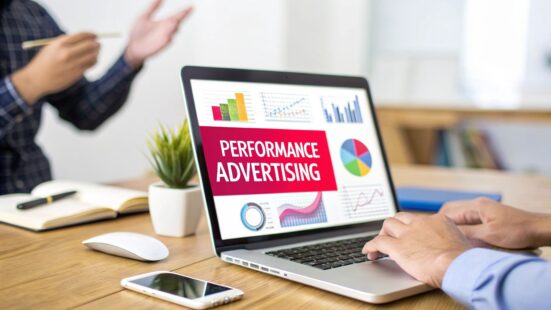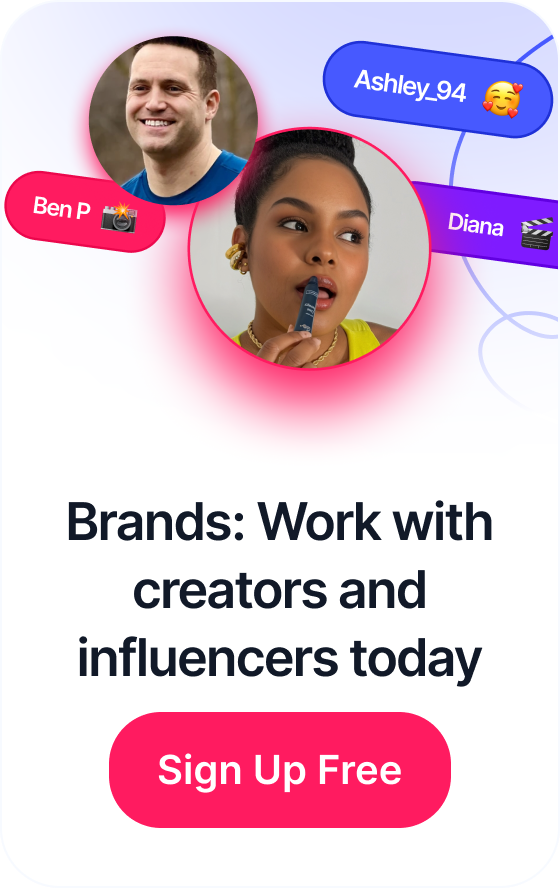 Your Guide to an AI Influencer Generator
Your Guide to an AI Influencer Generator
Picture this: you hire a salesperson, but instead of paying them a salary, you only pay them a commission for the deals they actually close. That’s the simple, powerful idea behind performance-based advertising.
You stop paying for your ad just to be seen and start paying only when someone takes a specific, valuable action—like clicking a link, signing up for your newsletter, or buying a product.
The Core Concept of Performance-Based Advertising

At its heart, performance-based advertising is a model where you only open your wallet when specific, pre-defined actions are completed. This completely flips the script, shifting the financial risk from you (the advertiser) to the publisher or ad platform. It’s a huge part of the broader strategy known as performance marketing.
This approach turns your marketing budget from a hopeful expense into a direct investment with measurable returns. Success is no longer about estimated eyeballs; it's about concrete outcomes that directly grow your business.
From Impressions to Actions
Traditional advertising often runs on what’s called an impression-based model (Cost Per Mille, or CPM). You pay a flat rate for every thousand times your ad is shown, whether anyone clicks or not. It’s great for building brand awareness, but it offers zero guarantee of actual engagement or sales.
Performance advertising is the exact opposite. The entire focus is on getting a user to do something meaningful. It's an incredibly efficient way to operate, tying every dollar you spend directly to a result you can measure.
This model has exploded in popularity. Programmatic buying, a key technology that powers performance ads, is expected to handle around 90% of all digital display ad purchases by 2025. The industry is all-in on results.
To give you a clearer picture, let's break down how this modern approach stacks up against the old way of doing things.
Performance Advertising vs Traditional Advertising
This table offers a quick comparison, highlighting the fundamental differences between paying for actions versus paying for attention.
| Attribute | Performance-Based Advertising | Traditional Advertising |
|---|---|---|
| Payment Model | Pay for specific actions (clicks, leads, sales) | Pay for impressions (views) or placement |
| Risk | Primarily on the publisher/platform | Primarily on the advertiser |
| Measurement | Highly trackable with clear ROI metrics | Difficult to measure direct impact on sales |
| Focus | Direct response and conversions | Brand awareness and reach |
| Optimization | Data-driven and continuous | Based on broad reach and frequency |
As you can see, the two are worlds apart. One is about casting a wide net, while the other is about precision fishing.
To make this all work, you absolutely need one thing: rock-solid tracking. You have to be able to accurately measure every click, lead, and sale to know what's working.
For example, learning how to master Facebook Ads conversion tracking isn't just a "nice-to-have" skill—it's essential for anyone serious about getting real returns from their ad spend. This detailed tracking ensures every dollar is accounted for, paving the way for predictable, scalable growth.
Now, let's get into the specific payment models that bring this powerful approach to life.
Table of Contents
Breaking Down The Core Payment Models
Performance advertising isn't just one single thing. It’s more like a toolkit, filled with different instruments you pull out for specific jobs. Each payment model is designed to link your ad spend directly to a tangible business goal, which makes your entire budget smarter and more accountable.
The real power here is that direct connection between spending and results. We're talking measurable ROI, serious cost efficiency, and the ability to target with incredible precision.
This infographic really captures the core benefits you get when you shift to a performance-based strategy.

As you can see, every piece of this approach is built to deliver clear, trackable outcomes—a far cry from the old days of just hoping for vague "brand exposure." Let's dive into the key models that make this all happen.
Key Performance Advertising Models Explained
To really get what performance advertising is, you have to understand how you pay for a user's action. The whole system is built around a few common models, each with its own strengths.
This table breaks down the big three you'll encounter most often.
| Model | What You Pay For | Best For |
|---|---|---|
| Cost Per Click (CPC) | A single click on your ad | Driving traffic to a website or landing page quickly. |
| Cost Per Lead (CPL) | A qualified lead (e.g., a form submission) | Businesses with longer sales cycles, like SaaS or high-ticket services. |
| Cost Per Acquisition (CPA) | A completed sale or conversion | E-commerce, affiliate marketing, and any direct-to-consumer sales. |
Let's unpack what these mean in the real world.
Cost Per Click (CPC): This is the most common starting point. You pay the publisher or platform only when someone actually clicks on your ad. A shoe company, for example, pays Google only when a shopper clicks their ad for "best running shoes." It’s a direct payment for a visitor.
Cost Per Lead (CPL): With CPL, you're paying for a potential customer. This is perfect for businesses where the sale doesn't happen instantly. Think of a software company paying for every user who fills out a "free trial signup" form. You haven't made a sale yet, but you have a qualified lead.
Cost Per Acquisition (CPA): Here's where the rubber really meets the road. Payment is tied directly to a sale. This is the heart and soul of affiliate marketing, where an online store pays a commission only after someone clicks an affiliate’s link and actually buys a product. If you want to go deeper on this, check out our guide on what is affiliate marketing.
The whole point is to stop paying for eyeballs and start investing in outcomes. You're putting your money toward a click that brings someone to your site, a lead that enters your sales funnel, or a sale that puts money in your pocket.
This results-first approach isn't just a theory; the numbers back it up. Social media advertising, which leans heavily on models like CPC and CPA, now makes up nearly 40% of all digital ad spending. And there's a good reason why: video ads, a key part of many performance campaigns, are known to outperform other formats by a staggering 120% in engagement rates.
Why Smart Businesses Are Making the Switch
The massive shift towards performance marketing isn't just another industry trend—it's a calculated business decision. Why? Because it’s built on radical transparency. You know exactly what every single dollar is doing for you, which turns marketing from a guessing game into a predictable science.
This isn't just a hunch; the numbers tell the same story. Back in 2011, global ad spend was around $384 billion, with digital being just a small piece of the pie. Fast forward to 2025, and that number is projected to blow past $1 trillion, with digital ads expected to claim about 75.2% of the total. That explosive growth is a direct result of performance advertising's superior tracking and ROI. Learn more about the growth of performance advertising.

Reduced Risk and Increased ROI
Beyond clarity, the other game-changer is the dramatic reduction in financial risk. By only paying when someone takes a specific action, you protect your budget from the hit-or-miss nature of traditional campaigns where you pay for eyeballs with no guarantee of results.
This pay-for-results model perfectly aligns the advertiser's goals with the publisher's incentives. It creates a genuine partnership focused on tangible outcomes. Every penny spent becomes an investment in measurable growth, not a gamble on potential reach.
Think about a small e-commerce store trying to get off the ground. A massive billboard campaign would be a huge, expensive shot in the dark with no clear way to measure what came of it. On the other hand, a targeted CPA campaign means every single dollar spent is directly tied to a sale.
This is what is performance based advertising in its purest form—it levels the playing field, empowering smaller businesses to compete with giants by scaling their operations efficiently and predictably.
Finding Your Stage: Where to Run Performance Campaigns
Knowing the rules of performance-based advertising is one thing, but knowing where to play the game is what separates winning campaigns from ones that just burn through your budget. Choosing the right channel isn't just a small detail; it's the foundation of your entire strategy.
Think of these platforms as different arenas, each with its own crowd and its own rules. Some are packed with people ready to buy right now, while others are perfect for finding that niche group of customers you thought was impossible to reach.
The Main Arenas for Performance Advertising
To get the results you're after, you have to meet your audience where they are. That means matching your campaign goals to the right platform. Here are the big ones you need to know:
Search Engine Marketing (SEM): Platforms like Google Ads and Bing Ads are the undisputed kings of intent. You're getting in front of people who are literally typing their problems into a search bar. Because you're targeting specific keywords, the Cost Per Click (CPC) model is the go-to here. You pay when someone interested enough to search for you actually clicks.
Social Media Advertising: Think Meta (Facebook and Instagram) or TikTok. These platforms are masters at slicing and dicing audiences based on demographics, interests, and behaviors. This is where you build brand awareness and get people thinking about you, often using CPC to drive traffic or CPL to capture early interest.
Affiliate Marketing: This is performance advertising in its purest form. Through networks like ShareASale or CJ Affiliate, you team up with partners—bloggers, influencers, and publishers—who promote your products for you. The beauty of it is that you usually pay on a Cost Per Acquisition (CPA) basis, meaning you only pay a commission when they make a sale. No sale, no fee. It’s that simple.
Native Advertising: Ever see those "recommended for you" articles at the bottom of a news site? That's native advertising. Platforms like Outbrain and Taboola let you place your content right alongside regular articles, so it feels less like an ad. This is a great way to drive traffic to your blog or other in-depth content, typically using a CPC model.
Picking the right channel is your starting point, but the real magic happens when you can track how customers move between them. Someone might see a native ad, then search for you on Google a week later before finally making a purchase. To really nail your ROI, understanding attribution modeling is essential for any advertiser. It's how you connect the dots and give credit where credit is due.
Common Challenges and How to Solve Them
Let's be real—while performance-based advertising sounds like a dream, it’s not always a walk in the park. There are a few hurdles you need to know about. Getting ahead of these issues is the difference between a campaign that sings and one that just drains your budget. The good news is, once you know what to look for, they're entirely manageable.

One of the biggest gremlins in the machine is ad fraud. This is when shady bots or straight-up bad actors generate a flood of fake clicks and leads, all designed to collect commissions without delivering a single real customer. It's a direct hit to your wallet.
Then there's the classic headache of complex conversion tracking. A single broken pixel or a misconfigured tag can throw your entire attribution model into chaos. When your data is garbage, you have no idea which ads are actually working, leading to terrible optimization choices and a lot of wasted spend.
Proactive Solutions for Common Hurdles
The key is to play offense, not defense. Instead of waiting for these problems to pop up and ruin your metrics, you can put systems in place to stop them before they even start.
Here’s how to keep your campaigns clean and on track:
Combat Ad Fraud: Don't go it alone. Use third-party fraud detection tools to analyze your traffic in real time. You should also get into the habit of regularly checking your analytics for weird patterns—like a suspiciously high click-through rate from one source or a batch of conversions at 3 AM.
Audit Your Tracking: Make your tracking health a top priority. Run regular audits on your pixels and tags to make sure everything is firing as it should. Using a tool like Google Tag Manager can be a lifesaver here, as it helps centralize your scripts and cuts down on setup errors.
Ensure Brand Safety: Your reputation is everything. Use exclusion lists to keep your ads from showing up on sketchy websites or next to content you wouldn't want your brand associated with. Most ad platforms have built-in brand safety filters that can automatically block these risky placements for you.
By proactively managing fraud, auditing your tracking, and locking down your brand safety, you turn these potential liabilities into strengths. It’s what ensures your performance-based advertising is not just profitable, but also sustainable and secure, protecting both your budget and your brand.
Ready to stop talking theory and start getting results? Let's walk through how to launch your first performance campaign. This isn't about throwing money at the wall and hoping something sticks; it's a step-by-step process for building a campaign that actually works.
Everything hinges on one simple question: what specific result are you paying for? Nail this down, and every other piece falls into place.
Define Your Core Objective
First things first, you need absolute clarity on your goal. What does a "win" look like for you? Is it a completed sale? A new lead from a contact form? Maybe it's a free trial sign-up.
Whatever it is, get laser-focused. This objective is the North Star for your entire campaign, guiding every decision you make from here on out.
Build Your Audience Persona
Next up, who are you trying to talk to? Don't settle for broad demographics like "women aged 25-40." Dig deeper.
Create a detailed persona. What keeps them up at night? Where do they hang out online? What motivates them to act? A crystal-clear audience persona is the secret to spending your ad budget wisely instead of just blasting your message into the void.
Set Your Budget and Bids
Okay, you know your goal and you know who you're targeting. Now it's time to talk money. Set a realistic budget you're comfortable with.
More importantly, figure out your target Cost Per Action (CPA) or Cost Per Lead (CPL). In plain English: how much is one of those "wins" worth to your business? This number is your guide for setting bids and making sure your campaign stays profitable.
Performance-based advertising isn't a "set it and forget it" machine. Think of it as a dynamic cycle: you monitor, you test, and you optimize. The goal is to drive progressively better results over time.
Finally, you'll need compelling ad copy and visuals with a strong call-to-action that makes people want to click. Once you launch, the real work begins—the ongoing process of tweaking and improving to get the best possible return on your investment.
Got Questions? We've Got Answers.
Even when you've got the basics down, a few questions always pop up when you start digging into performance-based advertising. Let's tackle some of the most common ones head-on.
Brand Marketing vs. Performance Marketing
So, what's the real difference? Think of it this way: performance marketing is all about getting someone to do something right now—click, buy, or sign up. It’s laser-focused on immediate, trackable actions, giving you a clear ROI for every dollar you spend.
Brand marketing, on the other hand, plays the long game. It’s about building a feeling, a reputation, and long-term loyalty. The results are harder to pin down on a spreadsheet in the short term. One is about immediate action; the other is about lasting perception.
How Much Should I Budget?
There's no magic number here, but a smart way to start is by figuring out your target Cost Per Acquisition (CPA) and working backward from there.
If you're just dipping your toes in, you don't need a massive budget. Even $10-$20 per day on a platform like Meta or Google Ads is enough to start gathering that all-important data. This lets you see what’s working before you pour more fuel on the fire.
The key isn't a huge upfront budget. It's about being committed to testing, learning from the data, and then scaling what works.
Is Performance Advertising Good for B2B?
Absolutely. The game is the same, just the "wins" look a little different. For a B2B company, a valuable action isn't always a direct sale. It might be a webinar signup, a whitepaper download, or a demo request.
These are all totally trackable under a Cost Per Lead (CPL) model. Platforms like LinkedIn are fantastic for this, letting you target specific job titles and industries with incredible precision, making it a powerhouse for B2B performance campaigns.
Ready to connect with a network of over 250,000 creators to drive your brand's growth? JoinBrands makes it easy to launch high-impact performance campaigns with TikTok Shop Affiliates, UGC creators, and influencers. Start accelerating your sales and amplifying your social presence today by visiting https://joinbrands.com.








